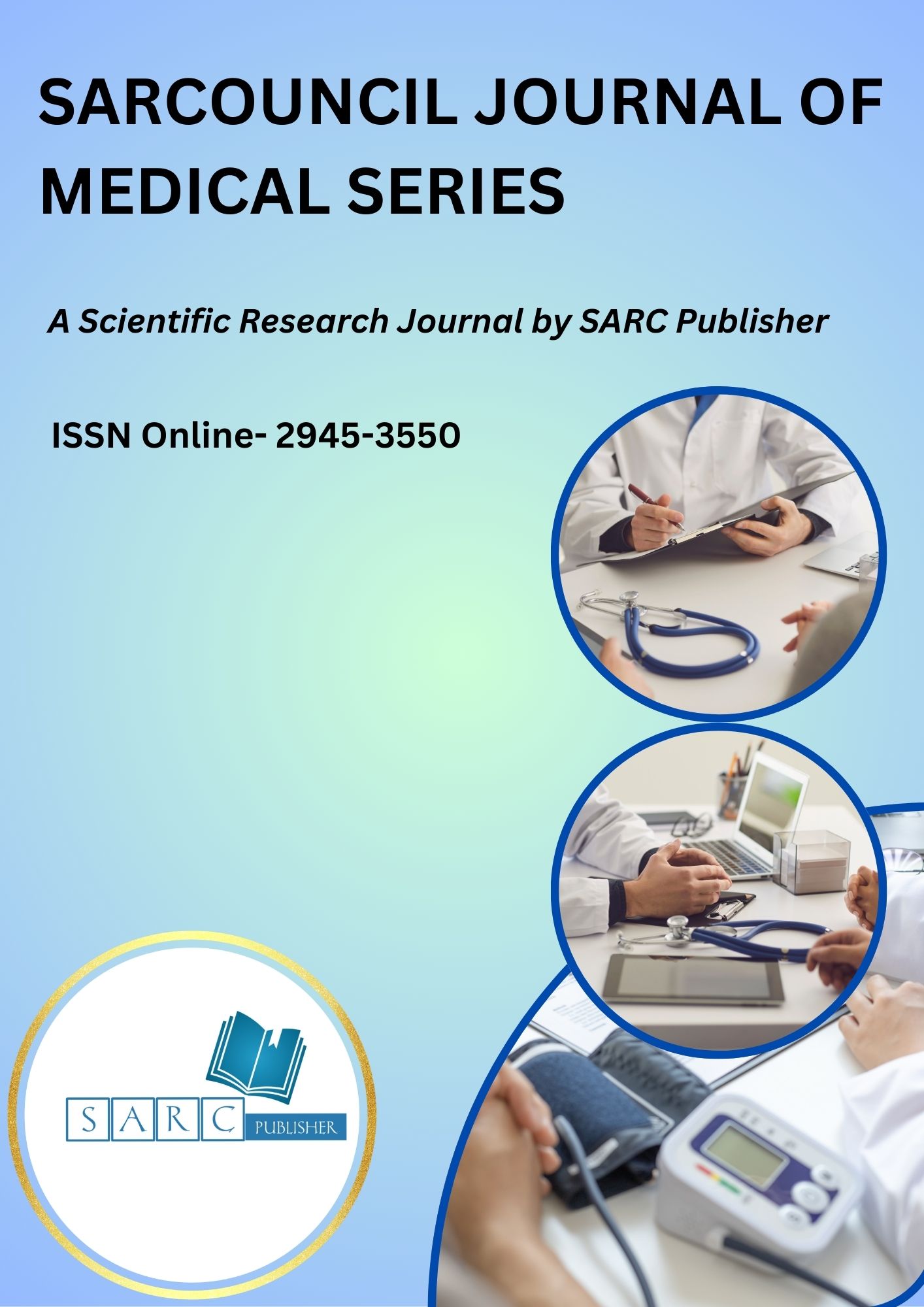Sarcouncil Journal of Medical Series

Sarcouncil Journal of Medical Series
An Open access peer reviewed international Journal
Publication Frequency- Monthly
Publisher Name-SARC Publisher
ISSN Online- 2945-3550
Country of origin- PHILIPPINES
Impact Factor- 3.7
Language- English
Keywords
- Pathology, Radiology, Serology, Surgery, Biochemistry, Biophysics, Cytology, Embryology, Endocrinology, Epidemiology, Genetics, Histology
Editors

Dr Hazim Abdul-Rahman
Associate Editor
Sarcouncil Journal of Applied Sciences

Entessar Al Jbawi
Associate Editor
Sarcouncil Journal of Multidisciplinary

Rishabh Rajesh Shanbhag
Associate Editor
Sarcouncil Journal of Engineering and Computer Sciences

Dr Md. Rezowan ur Rahman
Associate Editor
Sarcouncil Journal of Biomedical Sciences

Dr Ifeoma Christy
Associate Editor
Sarcouncil Journal of Entrepreneurship And Business Management
Pembrolizumab-Induced Myocarditis, Myositis, and Hepatitis in Elderly Patients with Malignancies
Keywords: pembrolizumab, myocarditis, myositis, side effects, hepatitis.
Abstract: We read with interest Watson, et al.’s article about three patients with pembrolizumab-induced myocarditis and myositis, who all developed muscle and cardiac symptoms 28, 11, and 23 days after the first cycle of pembrolizumab respectively, given for melanoma (patient-1, septuagenarian), melanoma (patient-2, octogenarian), and renal cell carcinoma (patient-3, octogenarian) [Watson, R. A. et al., 2024]. Patient-1 benefited from glucocorticoids, intravenous immunoglobulins (IVIG), pyridostigmine, and plasma exchange [Watson, R. A. et al., 2024]. Patient-2 benefited from glucocorticoids, coronary stent implantation, pacemaker implantation, and IVIG [Watson, R. A. et al., 2024]. Patient-3 died despite administration of glucocorticoids [Watson, R. A. et al., 2024]. The study is excellent, but some points need discussion. The first point is that the three patients were diagnosed with myocarditis based on the clinical presentation, elevated creatine-kinase, and troponin levels, and electrocardiography (ECG) abnormalities. However, for the diagnosis of myocarditis, it is imperative to document inflammatory changes on an endo-myocardial biopsy or document late enhancement on cardiac magnetic resonance imaging (MRI) with contrast. Have any of these examinations performed on the three patients? The second point is that patient-1 had elevated antibodies to the acetyl-choline receptor, but no further diagnostic management was reported [Watson, R. A. et al., 2024]. We should know the titre of these antibodies and their reference limits. We should also know whether low-frequency repetitive nerve stimulation in patient-1 showed a significant decremental response, whether small-fibre electromyography showed increased jitter and abnormal number of blocks, and whether the edrophonium test was positive. It must be also stated whether this patient had thymic hyperplasia or thymoma on mediastinal computed tomography. Which muscle groups were affected by myasthenia? According to table 1, patient-2 also suffered from myasthenia, but the diagnosis was made only clinically, which may be misleading, as it does not meet the established diagnostic criteria [Rousseff, R. T. et al., 2021]. The induction of myasthenia by pembrolizumab has been reported several times [Hutchinson, A. et al., 2024]. A third point is that comorbidities and concomitant medications were not reported in any of the three included patients. Of particular interest is whether any of the three patients had a history of primary or secondary myopathy and whether there was a family history positive of neuromuscular disorders. Subclinical metabolic myopathy could be the reason why not all, but only certain patients respond to immune-checkpoint inhibitors with myositis. It is also important to know whether any of the three received myotoxic medications in addition to glucocorticoids or pembrolizumab. These include statins, fibrates, chloroquine, hydroxychloroquine, colchicine, zidovudine, ranolazine, or other immune-checkpoint inhibitors [Mastaglia, F. L. et al., 2020]. We should also know if anyone of the three was an alcoholic. A fourth point is that all three patients were also diagnosed with hepatitis, but none of the three had hepatitis serology results reported and none of the three had undergone liver biopsy. As with myocarditis and myositis, the diagnosis of hepatitis should not be made on the basis of clinical appearance and serum levels of liver enzymes alone, but suspicion of this diagnosis should be confirmed or excluded by an established diagnostic work-up. A fifth point is that electromyography (EMG) cannot detect a necrotic process in the striated muscle as reported for patient-1 [Watson, R. A. et al., 2024]. Muscle necrosis can only be detected by histological examination and visualisation of myocyte necrosis. In summary, the excellent study has limitations that should be addressed before final conclusions are drawn. Clarifying the weaknesses would strengthen the conclusions and improve the study. For the diagnosis of myocarditis, myositis, and hepatitis, confirmation of inflammation by histological or imaging methods is mandatory
Author
- Josef Finsterer
- MD; PhD; Neurology & Neurophysiology Center; Vienna; Austria.

